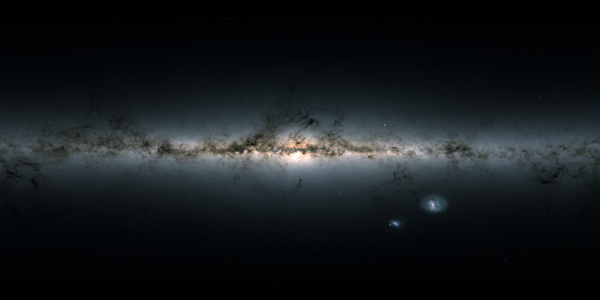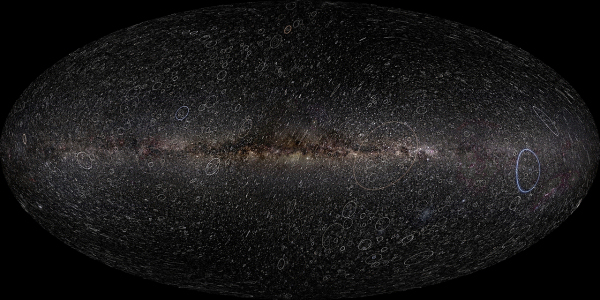Rethinking everything we thought we knew about star clusters
26 February 2019
ESA's Gaia satellite is on a mission: to map and characterise more than one billion of the stars in the Milky Way. Many of these stars reside in complex, eye-catching clusters scattered throughout our Galaxy and, by studying these stellar groupings, Gaia is revealing much about the formation and evolution of stars in our cosmic home and surroundings. |
| Gaia's view of the sky. Credit: ESA/Gaia/DPAC, CC BY-SA 3.0 IGO |
The Milky Way is full of stars. Our Galaxy contains over a hundred billion of them, from dwarf to giant, populating its crowded centre and its spiralling disc.
Many of these stars are thought to have formed in the same way: from huge clouds of cool, condensing molecular gas, which collapse under the influence of gravity and fragment to form groups of hundreds to thousands of stars, known as star clusters. Some of these clusters last thousands of millions of years, while others disperse rapidly, releasing their stellar residents into the Milky Way's disc.
It is likely that also our Sun formed in a cluster some 4.5 billion years ago, and the quest for solar siblings – stars that were born in the same cluster as the Sun and then went on different paths – will provide important information on the birth of our parent star.
Despite our growing knowledge, many open questions remain. For instance, how many clusters exist, how many are currently being formed, how many are falling apart – and at what pace?
The incredible diversity of stars and their birth clusters is currently being explored by ESA's Gaia satellite.
Launched in December 2013, Gaia aims to map the nearby cosmos and execute the most extensive census of stars ever performed, tracking the positions, motions, and properties of more than one billion stars in the Milky Way and its surroundings. So far, the mission has released two packages of data: Data Release 1 (DR1) on 14 September 2016, and Data Release 2 (DR2) on 25 April 2018.
| Comparison between Gaia's first (left) and second (right) data releases. Click here for details and large versions of the video. Credit: ESA/Gaia/DPAC, CC BY-SA 3.0 IGO |
"The first release was planned as more of a test release than a full database, and the second is still early days for Gaia," says Carme Jordi of the University of Barcelona, Spain, a member of the Gaia Science Team. "Nonetheless, these datasets have already offered us unique insights into the stars within our Galaxy, and in particular into stellar clusters."
Gaia DR1 contained the positions and brightnesses of 1.1 billion stars, and the parallaxes (a way of measuring distance) and proper motions (movement through the sky) for a subset of two million. Gaia DR2 raises these figures to nearly 1.7 billion stars in terms of positions and brightnesses, over 1.3 billion in terms of parallax and proper motion, and adds new data about stellar colours, line-of-sight velocities, surface temperatures, variability, radii, luminosities, and more.
With Gaia DR2, the mission has provided scientists with new tools to look at star clusters in the Sun's neighbourhood and beyond.
New clusters unveiled
Alfred Castro-Ginard and colleagues used a statistical method on a subset of Gaia DR1 to discover 21 nearby clusters that had previously gone unnoticed, confirming their findings using the full DR2 data. So far, even if not unanimously, scientists had generally thought that all such clusters out to distances between 3200 and 6500 light-years from Earth had been identified – but this study suggests that there is still much to discover, even in our cosmic neck of the woods.
"It's worth noting that this study only looked at a small part of the sky," explains Jordi. "The discovery of new nearby clusters, which should be the easiest to detect, indicates that our knowledge of these clusters is really quite incomplete out to greater distances."
 |
| Parallaxes in Gaia's sky. Credit: ESA/Gaia/DPAC, CC BY-SA 3.0 IGO |
This finding was soon followed and supported by a different study, led by Tristan Cantat-Gaudin, which re-analysed every previously reported cluster, known and putative alike, using data from Gaia DR2. This research confirmed earlier detections of about 1200 clusters, and determined their average distance and overall motion.
The scientists also serendipitously discovered 60 new potential clusters, but also surprisingly discarded clusters that had previously been identified. The study revealed that many such clusters are actually overlapping groups consisting of more than one cluster, while others are just asterisms – apparent patterns or groupings of stars that are in fact tricks of perspective on the two-dimensional sky.
Another study by Cantat-Gaudin and collaborators focussed on a nearby stellar group known as Vela OB2, which is somewhat looser than an ordinary cluster. Gaia's precision allowed the scientists to study stellar motions within Vela OB2 in great detail, revealing that it comprises multiple smaller clumps of stars and that the overall complex is expanding. They used the data to unravel the history of this stellar group, which is associated with a large, expanding nearby shell of gas known as the IRAS Vela Shell and thought to have originated in a supernova explosion: according to Gaia, the powerful event that triggered this shell also sparked the formation of Vela OB2's stars over 10 million years ago.
"Gaia's extraordinary data are allowing us to revisit our existing stellar census and confirm, discard, and discover clusters," says Jordi, who is a co-author on all three studies. "This is invaluable in helping us to characterise the distribution of clusters throughout the Milky Way's disc, and their height in relation to the Galactic plane."
Tracing clusters across the Galaxy
On a broader Galactic scale, the new cluster counts that scientist have started to put together with Gaia seems to indicate that clusters sitting high above the plane of the Milky Way are old, and located further from our Galaxy's centre.
"It seems there aren't old clusters at high altitudes in the inner part of the Galactic disc, so they must have dissolved – just as our models predict," explains Jordi.
Looking specifically at clusters in higher-altitude areas of our Galaxy's disc by combining positions and motions on the sky from Gaia DR2 with line-of-sight velocities from a ground-based survey, Janez Kos and colleagues discarded the existence of four out of the five analysed clusters.
In a different study, Caroline Soubiran and colleagues used line-of-sight velocities from Gaia DR2 to explore the kinematics of 861 stellar clusters, and found them to follow the velocity distribution of field stars – stars that are not associated to any cluster – in the solar neighbourhood.
Precise data from Gaia DR2 also contributed to revealing the ongoing evaporation of the nearest cluster to the Sun, the Hyades, in two independent studies led by Stefan Meingast and Siegfried Röser, respectively. This cluster was found to boast two well-defined tidal tails containing hundreds of stars, each extending from the cluster's core in a distinct 'S' shape.
| Flythrough the Gaia data, towards the Hyades cluster. Click here for details and large versions of the video. Credit: ESA/Gaia/DPAC, CC BY-SA 3.0 IGO |
"This unique finding opens a new window for studying how clusters, through their gradual demise under the influence of the Milky Way's gravity, continuously feed the Galactic disc with stars," says Jordi.
Clusters as stellar test-beds
Star clusters are not only tracers of how the disc of our Galaxy has evolved over time, but also excellent laboratories for studying stellar physics. With its unprecedented data, Gaia has started to reveal previously unseen details that have an impact on our understanding of the formation and evolution of stars.
By plotting the colour of stars against their brightness, astronomers have been using the so-called Hertzsprung-Russell (HR) diagram to study the evolution of stellar populations for over a century. In this diagram, most stars lie along a top-left to bottom-right diagonal line known as the 'main sequence' – which identifies stars in their prime, burning hydrogen fuel in their cores – while stars in later stages of their lives are found away from this sequence.
| The Hertzsprung-Russell diagram. Click here for details and large versions of the video. Credit: ESA/Gaia/DPAC, CC BY-SA 3.0 IGO |
In clusters, which were historically thought to contain a single, simple population of stars that formed all at the same time, the position in the diagram where the main sequence 'turns off' was customarily used to estimate the age of that particular stellar population. However, in recent years, scientists had found evidence that clusters may comprise more than one population of stars, based on the observation of multiple turn-off points in their HR diagrams.
Gaia is now calling for a rethink of this phenomenon, as several studies based on its latest dataset seem to indicate how the multiple turn-off points can be explained without invoking several populations of stars, but rather by properly including the effects of the rotation of cluster stars on their predicted colours. For example, Anna Marino and colleagues conducted two studies using photometric data from Gaia DR2 to suggest that this is a common feature in Milky Way clusters, while Beomdu Lim and colleagues found a similar result by combining Gaia proper motions with ground-based spectroscopic observations of M11, also known as the 'Wild Duck' cluster. Similarly, Giacomo Cordoni and colleagues used a mix of stellar velocity, photometry, and proper motion data to confirm that rotational effects of stars can affect their estimated colours and lifespans.
This is certainly not the final word on stellar clusters, and many more studies will follow in coming years and clarify, reopen, and perhaps even deepen these intriguing topics. Like every great mission or experiment, Gaia is providing scientists with precise and plentiful data that are increasing our understanding of many astronomical problems, giving rise to new and more profound questions as our knowledge grows.
"Gaia is unique and revolutionising all fields of astrophysics, with this recent research on star clusters being a good example," says Jos de Bruijne, Gaia deputy project scientist at ESA.
"The mission has given us precise measurements of how stars move through space and their distances from us… and it has done this for over one billion stars. We've never had anything like this database before, and it's invaluable in helping us study our Galaxy.
"The recent star-cluster discoveries make this a hugely exciting area of research – especially as we have more Gaia data releases to look forward to in coming years."
More information
ESA's Gaia satellite was launched in 2013 to create the most precise three-dimensional map of more than one billion stars in the Milky Way. The mission has released two lots of data so far: Gaia Data Release 1 on 14 September 2016, and Gaia Data Release 2 on 25 April 2018. More releases will follow in coming years.
Explore an interactive visualisation of Gaia data from 47 stellar clusters here.





